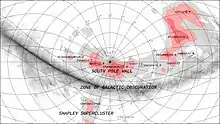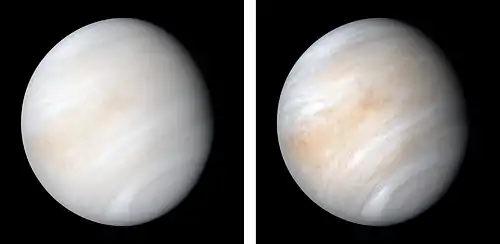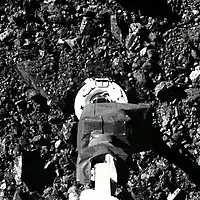South Pole Wall
The South Pole Wall (SPW or The South Pole Wall) is a massive cosmic structure formed by a giant wall of galaxies (a galaxy filament) that extends across at least 1.37 billion light-years of space, and is located approximately a half billion light-years away.[1][2][3][4][5][6] The structure, in its astronomical angle, is dense in five known places including one very near to the celestial South Pole and is, according to the international team of astronomers that discovered the South Pole Wall, "...the largest contiguous feature in the local volume and comparable to the Sloan Great Wall at half the distance ...".[1] Its discovery was announced by Daniel Pomarède of Paris-Saclay University and R. Brent Tully and colleagues of the University of Hawaii in July 2020.[1] Pomarède explained, "One might wonder how such a large and not-so distant structure remained unnoticed. This is due to its location in a region of the sky that has not been completely surveyed, and where direct observations are hindered by foreground patches of galactic dust and clouds. We have found it thanks to its gravitational influence, imprinted in the velocities of a sample of galaxies".[3]

Size
The wall measures over 1.37 billion light-years in length, and spans a large zone 500 million light-years away.[4][5] The massive structure, at least to a very small extent, is behind the Milky Way galaxy's Zone of Avoidance (or Zone of Galactic Obscuration).[6][7] The filament curves from the Perseus constellation in the Northern Hemisphere to Telescopium in the far south, in between which, skirting ‐ slightly ‐ over the present south celestial pole itself. It is so large that it greatly affects the local expansion of the universe.[4] According to astronomer Tully, "We wonder if the South Pole Wall is much bigger than what we see. What we have mapped stretches across the full domain of the region we have surveyed. We are early explorers of the cosmos, extending our maps into unknown territory."[3] According to the astronomers who discovered it "We will not be certain of its full extent, nor whether it is unusual, until we map the universe on a significantly grander scale."[5]
See also
References
- Pomarède, Daniel; et al. (10 July 2020). "Cosmicflows-3: The South Pole Wall". The Astrophysical Journal. 897 (2). arXiv:2007.04414. doi:10.3847/1538-4357/ab9952. Retrieved 10 July 2020.
- Pomerede, D.; et al. (January 2020). "The South Pole Wall". Harvard University. Retrieved 10 July 2020.
- Staff (10 July 2020). "Astronomers map massive structure beyond Laniakea Supercluster". University of Hawaii. Retrieved 10 July 2020.
- Overbye, Dennis (10 July 2020). "Beyond the Milky Way, a Galactic Wall - Astronomers have discovered a vast assemblage of galaxies hidden behind our own, in the "zone of avoidance."". The New York Times. Retrieved 10 July 2020.
- Mann, Adam (10 July 2020). "Astronomers discover South Pole Wall, a gigantic structure stretching 1.4 billion light-years across". Live Science. Retrieved 10 July 2020.
- Starr, Michelle (14 July 2020). "A Giant 'Wall' of Galaxies Has Been Found Stretching Across The Universe". ScienceAlert.com. Retrieved 19 July 2020.
- O'Reilly, Aaron (11 July 2020). "Is the zone of galactic obscuration, that is beyond the cosmic south pole wall, the edge of our sub-reality? Or is the boundary where decoherence stops being a thing?". Quora. Retrieved 19 July 2020. NOTE: "The 'Zone of Galactic Obscuration' is, simply as it says, an area of the sky where the hub of the Milky Way galaxy itself makes observations very difficult by obscuring what is going on. This is defined purely by our location relative to the galactic hub, and is not an actual object in itself."
External links
- South Pole Wall – Official Site
- South Pole Wall – video (6:50) on YouTube (Daniel Pomarède; 10 July 2020)


_on_Jul_14_2020_aligned_to_stars.jpg.webp)